Last updated on 10th January 2024
If gaining popularity on YouTube is a mystery to you, then you’re in the right place!
When casting an envious eye at the millions of views enjoyed by the most successful YouTube channels and popular videos, it’s easy to put that good fortune down to the fact that the channel was already established and had an unfair head start.
But remember, every single YouTube channel started with 0 views and 0 subscribers. Every single one.
So how can one video about [enter any subject here!] accumulate millions of views, while another video about the same subject can barely reach ten people?
The answer isn’t elusive or mysterious. The answer is YouTube SEO.
If you want people to see your YouTube content, then you need to optimise your videos to be discovered.
We’re here with good news: it IS possible to rank higher on YouTube! You just need to know how – and in this post, we’ll talk all about it!
How does YouTube SEO work?
Like any search engine, YouTube video rankings are determined by a complex algorithm, but our advice is not to get caught up in trying to understand every single factor.
Instead, just remember the ‘goal’ of any search engine: to give searchers the best quality content, which best matches what they’re looking for.
– ‘Technical’ SEO signposts like YouTube video description, transcript, title, description and tags, which tell the algorithm what your content’s about.
– Human’ SEO signals which tell the algorithm whether the people who watch your YouTube content think it’s any good: stuff like watch time, click rate, retention and user engagement.
In many ways YouTube SEO is more straightforward than other search engines.
Why?
Because, unlike Google and others, which give real weight backlink profiles, domain metrics and other complex factors to evaluate rank, YouTube SEO pretty much boils down to optimising things you can control: making awesome videos, and signposting them properly with technical stuff like video descriptions, playlists and metadata.
Whichever way you slice it, the success of any YouTube channel depends on being able to slide your content into those precious YouTube search results.
So let’s demystify the whole thing: let’s take a look at 10 ways to nail YouTube SEO, optimise your videos and channel, and, ultimately, get more viewers!
How to rank YouTube videos fast
1. Have a focus keyword
The first of our YouTube SEO tips is all about keywords.
Whether you’ve already posted your videos on YouTube, or you haven’t even pressed record yet, targeting a relevant keyword to base each video around will really help your YouTube SEO efforts.
Like all search engines, YouTube works by matching the users search term with the most relevant and highest quality results.
If you’re jazzing up old YouTube videos, re-watch them and try to pinpoint the main topic. Ask yourself: What is the focus of this video? What is the key word? (And be creative here: think tangentially.)
For future videos, it’s easier if you choose relevant keywords before you start. That way, you can use a keyword research tool to help you find the most popular search terms to use. This can help you ideate content on your channel.
Popular keyword research tools include: Ahrefs, SEMrush, Keywords Everywhere, and KeywordTool.io.
They all work in a similar way, but KeywordTool.io. is the most ‘beginner’ friendly if you’re new to keyword research.
You just select your chosen search engine–in this case, YouTube–and then enter your chosen keyword. We’ve gone with ‘Instagram Hacks‘:

The free version of the tool gives you a list of the most popular keywords relating to your search term, like this:

But with the pro version, you can dig a little deeper by also comparing search volume, CPC (cost-per-click), and competition. (There’s no need to get hung up on the latter two – they’re metrics that give you a rough idea of how challenging a keyword will be to rank for, but they’re not always reliable indicators. Volume, however, is pretty important. This is a pretty good indicator of how popular and widely searched your topic is, and can help you work out what to make videos about, and in what order of priority.)
Once you’ve used one of the above tools to identify popular keywords that closely match the topic of your video, jot them down or export a list – and carry on reading this article for tips on how to use it to rank higher.
Keywords aren’t everything, but diligent keyword research certainly offers a good starting point in the world of YouTube SEO!
2. Optimise the video title
Once you’ve got your keyword, you can begin to use it to optimise your video in different ways to help improve your YouTube ranking.
One of the simplest ways to do this is to include the keyword in your video title.
But, with 400 hours of video uploaded to YouTube every minute(!), a keyword alone is not going to be enough to give you a huge YouTube SEO boost.
Your video title needs to be compelling. It needs to send a message to YouTube users that says ‘Click me!‘
A great way to do this is to promise something: Are you going to teach your viewers something? Are you going to entertain them? Let them know what they’re about to watch. Take a look at the results below for our keyword ‘instagram hacks’:
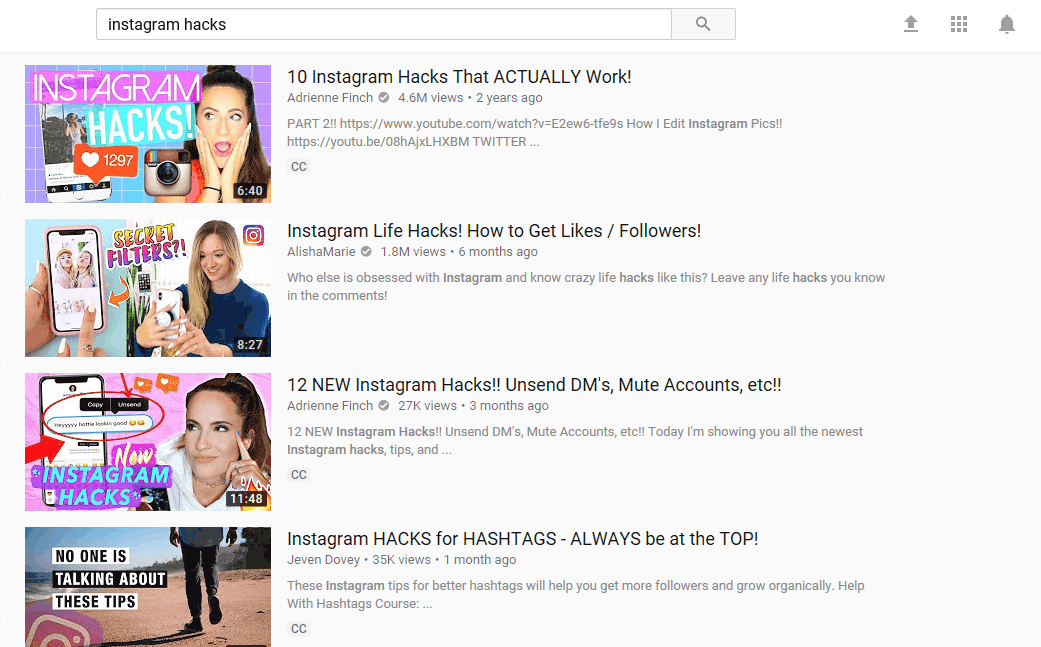
The highest-ranking YouTube videos for this keyword promise to teach their viewers something new–and, of course, they all include the keyword verbatim.
But they also have a little bit of extra description. The title ‘Instagram Hacks’ is not enough to gain views, or even ‘I will teach you instagram hacks.’
You need to think deeper.
Let your viewers know exactly how many hacks you are going to teach them, or promise them something specific and highly sought-after like the second video in the above example.
Including these promises in your video title – without exceeding the maximum character limit – is a great way to attract clicks.
And, if YouTube’s search algorithm picks you up , guess what? You get a tasty boost in the YouTube search results. This is because YouTube’s automated algorithm notices that more people think your content is going to answer their question.
3. Optimise the video description
In addition to optimising your title, you also need to optimise your video description.
Now, while your title is mainly to catch the eye of potential viewers, you can be a little more in-depth with your description.
YouTube displays the first 125 characters of your description, but it is a good idea to write around double that–aiming for 250 words if you can. YouTube also recommends that you put the most important keywords toward the beginning of your video description.
Of course, it’s not all about the algorithm. Your viewers will be reading this too, so make sure you keep their engagement in mind. Writing exclusively for robots is never a good idea!
1. Don’t forget to include your target keyword(s) if possible.
2. Make sure you write something unique. Don’t just copy and paste some text from your website or elsewhere.
3. Include your website URL to direct viewers to your site.
Take a look at this example:
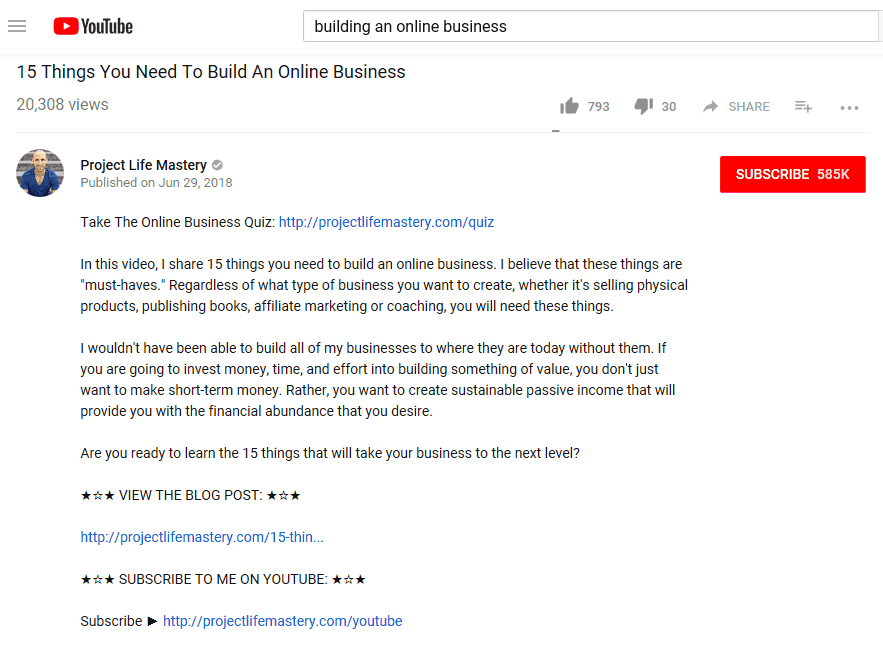
Straight away we can see a link to the creator’s website. Then below that are a couple of lengthy paragraphs about the video, including the title of the video and the keyword (build an online business) in the very first sentence.
A unique, optimised description like this allows YouTube to understand what your video is about and then put it in front of the right people.
4. Include the right tags
After placing your keyword(s) in your title and description, you also want to put them in the ‘tags’ section.
Tags are for YouTube’s reference only, so your viewers won’t see what you include. And – full disclosure – it’s hotly contested how much weight these actually carry in YouTube’s algorithm: the consensus is ‘not much.’ But this is so quick to do, it’s a no-brainer.
Feel free to add as many variations of your keywords and search terms as you can think of.
If we stick with the ‘Instagram Hacks’ example, here are 7 you could use:
- Instagram Hacks
- Hacks
- Life Hacks
- Social Media Hacks
- Social Media
- Social Media Tips
Notice that they don’t need to be super-specific.
There is a Chrome Extension for YouTube called TubeBuddy.
Among many other features is keyword rank tracking, and this allows you to find out the search ranking for different tags so you can use the best ones for SEO.
You might also consider using an app like VidIQ to help you see what tags your competitors are using. By using the same tags as your competitors, your videos will start ranking in the ‘Up Next’ section whenever someone watches their videos–so you can direct attention from them to you!
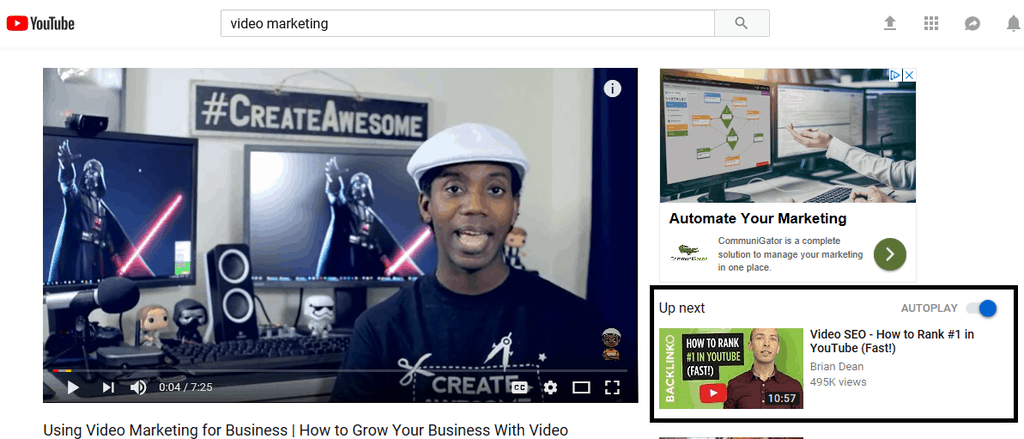
5. Create an engaging script
You might be tempted to skip this point.
After all, scripts are wooden and awkward, and you want to come across as natural and spontaneous, right?
Well, an engaging, well-written script can actually give you a better chance of coming across as natural and spontaneous, while at the same time ensuring you don’t get sidetracked and lose viewers.
A script can help you tighten up your language, cut out the “ums”, “ahs”, and “where was I?” and grab your viewers’ attention. It can also make your video a helluva lot quicker to create – so you can concentrate on knocking out more content.
A study by AdAge in 2015 (a lifetime ago in video marketing years) found that marketers have just 10 seconds to capture and engage their audience before losing them.
Their study also found that if your audience isn’t fully engaged by the first 30 seconds, then you’ve likely lost 33% of them. And remember, that was in 2015! It’s even more difficult now.
So make sure you write a script with a short and snappy intro, one that gets to the point quickly and informs viewers why they should stay tuned. Think of it as an expansion on your title–set a promise at the start that you will fulfil by the end.
Another simple tip – SAY your target keyword in your video. YouTube is increasingly adept at being able to automatically ‘listen’ to your video and transcribe it, and if you say your target keyword, ideally early and a couple of times – organically, of course, so it’s natural to a human audience – you may find you get a little rankings boost.
6. Start making longer videos
Despite popular belief, longer videos actually outperform shorter ones when it comes to YouTube. Type any keyword or phrase into YouTube and usually the top-ranking videos are pretty lengthy:
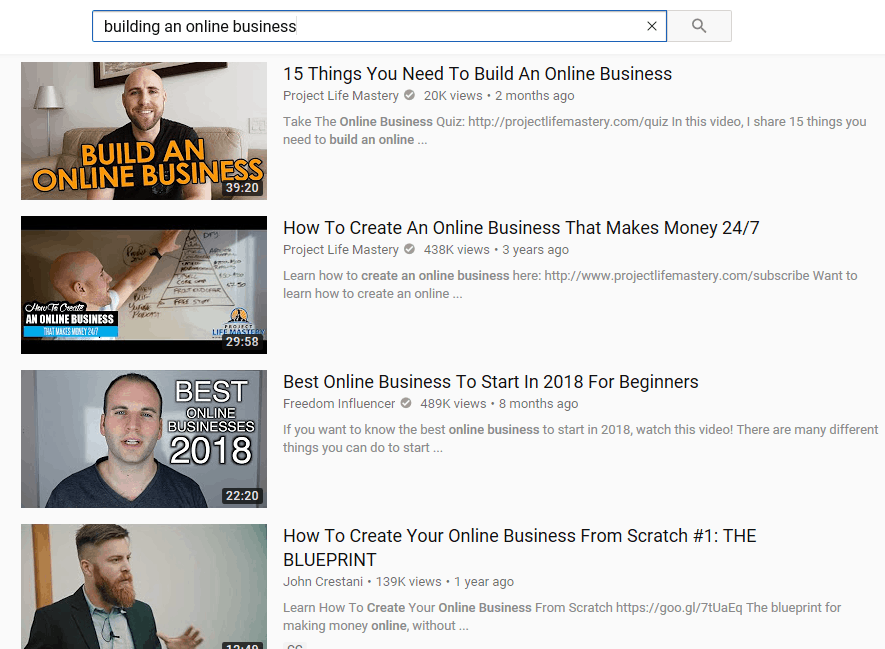
In fact, it’s widely believed that YouTube actually uses total view duration as a ranking factor. It makes sense if you think about it–the longer you watch, the more engaged you are, the more likely you are to watch more videos and the more likely you are to see the advertisements – which means YouTube does well commercially, too!!
The longer your videos are watched, the higher your rankings are likely to be. This naturally means YouTube favours longer, high retention videos that audiences stick around watching for longer periods.
However, this doesn’t mean that you should try and drag your videos out for as long as possible, it just means that you should tend towards answering questions fully and comprehensively rather than breaking one video into five parts.
If your videos are long and comprehensive, yet still engaging enough to keep viewers watching, YouTube will definitely take note and you’ll start to rank higher.
7. Encourage engagement
There’s a reason that seemingly every YouTube video ends with: “If you liked this video, click the like button down below, and don’t forget to subscribe for more content…”
…or some variation.
Not only does this grow a creator’s audience and make it easier to reach past viewers with future content, it also sends out a healthy SEO signal. Think about it: every like, comment, or channel sub, is a vote of confidence in your content. It says: This was awesome. Take a look at this chart:

This is from a study of 1.3 million YouTube videos by Brian Dean, founder of Backlinko, and it shows a clear correlation between video comments and YouTube ranking.
Encouraging engagement is one of the easiest YouTube SEO tips to implement, and can make a significant difference to the performance of your YouTube content.
8. Create an interesting video thumbnail
There are only two things a viewer sees before deciding to click on your video: The video title and the video thumbnail. And, with visual information processed 60,000 faster than text, that thumbnail really counts!
YouTube does automatically assign a video thumbnail to you, but this will just be a random shot from the video.
In order to stand out, you need to use a unique, attention-grabbing image that will encourage people to click. Take a look at the examples below:
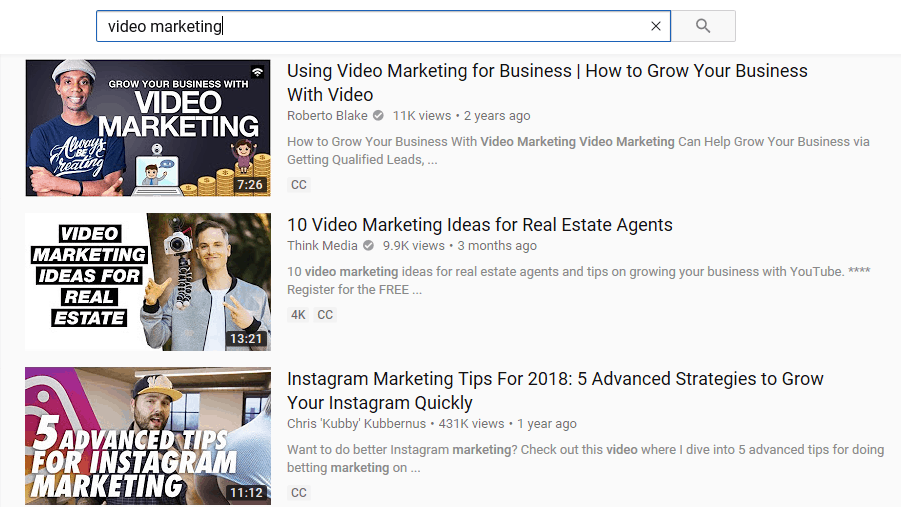
Each thumbnail has been selected to draw viewers in. The presenters are looking directly at the camera and the text on screen further reiterates what the video is going to be about. Illustrated elements in the thumbnail in contrasting colours help capture the eye and give a professional vibe.
In some ways, you can think of YouTube’s SERP as like a digital storefront: you’re selling your content, and searchers are spending their time. On any SERP, you need to stand out as the BEST, most PROFESSIONAL, most THOROUGH content on the topic they’ve searched for.
This encourages users to click on the video, and (broken record alert!) a high click-through rate will seriously strengthen your ranking performance, because it’s another chance for YouTube’s algorithm to notice: Hey, this is clearly the go-to content on that topic.
9. Create playlists
Playlists are an amazing way to increase the overall watch time of your channel because they play automatically. So instead of watching just one video, a viewer might watch five or six of your other videos!
Again: watch time is really important to YouTube SEO.
To create a playlist, you need to group a couple of videos together that have a similar topic or theme, like this:
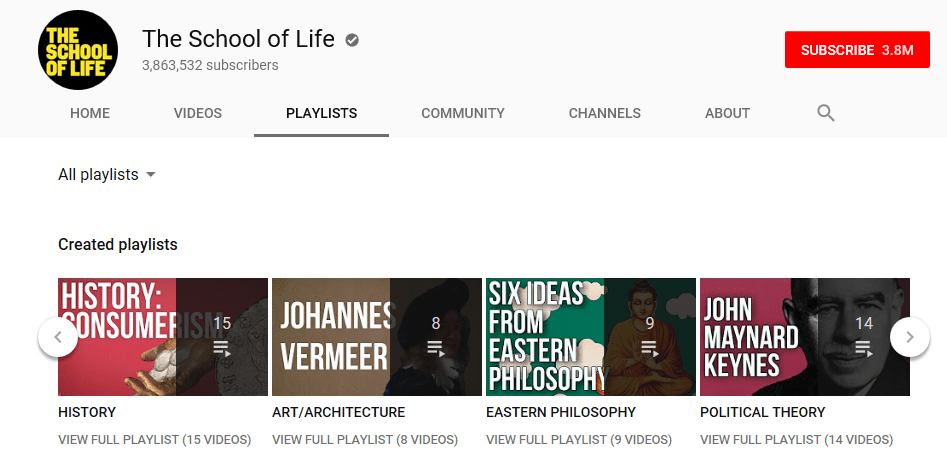
It also helps to get in touch with people who create similar content to you (but aren’t your competitors!) and ask them to add your videos to one of their playlists. The more playlists your videos are featured in, the better!
Here’s an example of what you could say:
“Hey [NAME],
I LOVE your channel! Your recent video about [TOPIC] was really interesting to me because [ADD COMPLIMENTS & SHOW INTEREST].
I think my videos are pretty similar to yours, so it could help viewers stay on your channel if you included some of my content in your playlists. Here are some videos I think would fit:
[INCLUDE LINKS]
I’d be happy to return the favour. Just let me know which of your videos you would like me to pop into my playlists.
Keep up the great work!
[YOUR NAME]”
When you contact these people, make sure you let them know why it is good for them too. You don’t want them to think you are simply asking for a favour. By including your videos in their playlists, they can cater to their viewers’ needs and also increase their own watch-time. It also helps to offer to include their videos in your playlists too–sort of like a swap!
10. Add closed captions
YouTube videos are able to support closed captions to benefit people with hearing difficulties
An added bonus of these captions is that they are crawled by YouTube and Google, so they can work to boost your YouTube SEO!
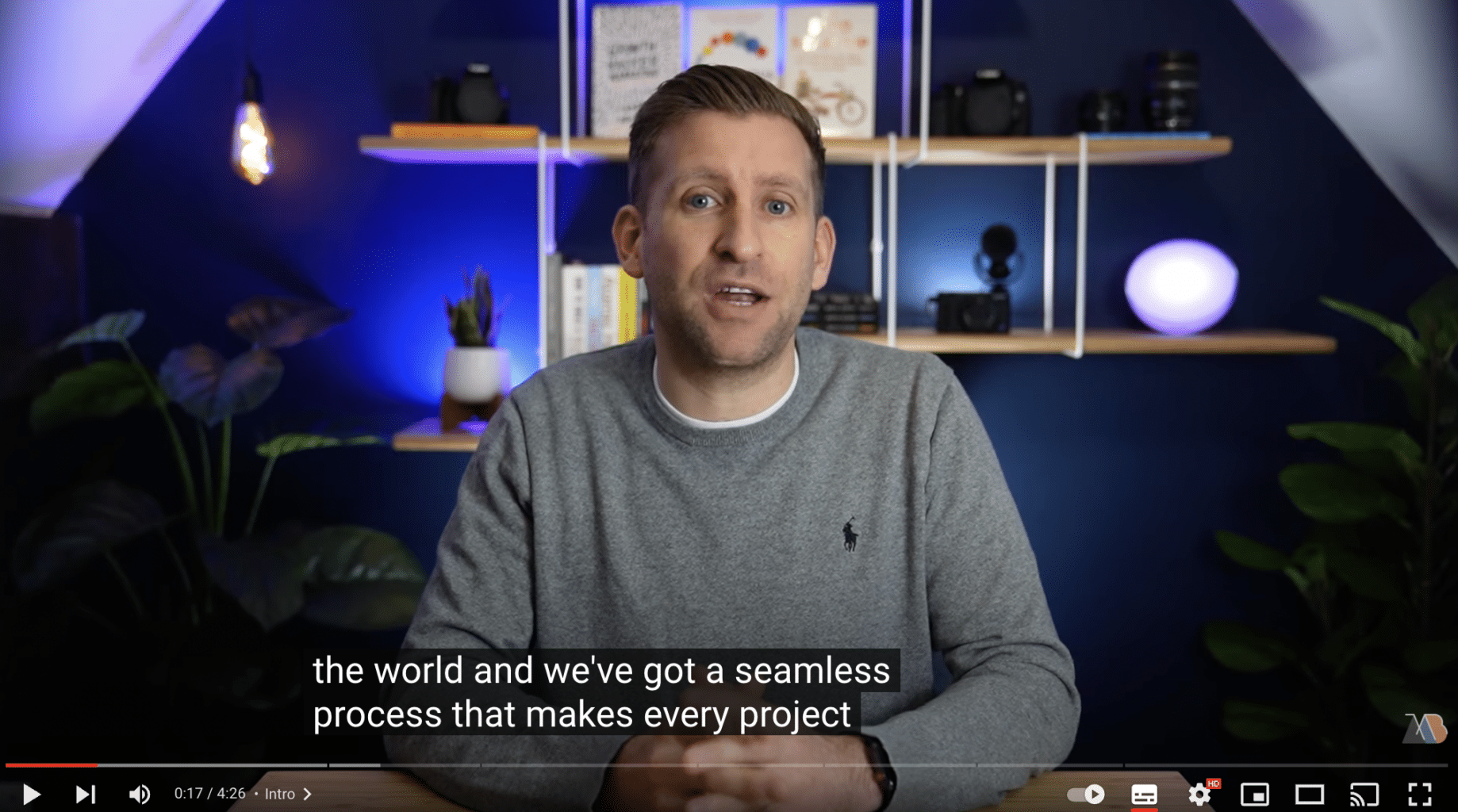
YouTube can automatically caption your videos, but this is usually riddled with errors.
To get your closed captions indexed and make them YouTube SEO-friendly, you need to edit the captions YouTube provides based on transcribing your video file – or upload your own. Here’s how:
Top 3 YouTube SEO tools
Another piece of good news is that you don’t have to go it alone. There are plenty of software tools out there to help you nail video SEO like a pro. Here are our top 5…
Keyword research: Ahrefs Keyword Explorer
Ahrefs is an industry leader in keyword research and it’s great for YouTube research too. You can use their Keyword Explorer tool to find keywords that you can rank for, as well as get ideas for new videos.
Channel management: TubeBuddy
TubeBuddy is a great tool for managing your YouTube channel. It lets you do things like bulk upload videos, add custom thumbnails, and optimise your tags and titles.
Channel artwork: Canva
And – because we need to make sure we stand out to our human audience on that search results page, too – let’s talk about Canva.
Canva is a great tool for creating custom thumbnails and artwork for your videos. You can create professional-looking graphics without having to hire a designer. They even have pre-made templates so you can get great looking video thumbnails with minimal effort! It’s still worth checking the latest YouTube banner aspect ratio and resolution guidelines though.
Closing thoughts
YouTube is a competitive place to share your content because there are SO many people visiting it on a daily basis. And while the competitiveness can be off-putting at times, you just need to remember that there are still many ways you can rank videos higher and improve your YouTube SEO to make your channel and your videos more lucrative for your business.
If you’re struggling to come up with top video content ideas in the first place, our blog post: 21 YouTube Video Ideas for Businesses, would be the perfect place to start. Or, if you’d like to know how we can help with video creation, visit our YouTube video information page.







